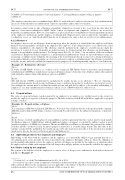Page 660 - SAIT Compendium 2016 Volume2
P. 660
IN 77 Income Tax acT: InTeRPReTaTIon noTes IN 77 = (R600 × 250 total business minutes / 820 total minutes) + (210 paid business minutes × R2 per minute)
= R602,93.
The employee may therefore be reimbursed up to R602,93 and it will not be subject to income tax. Any reimbursement in excess of this amount is a reimbursement of private expenditure and is subject to taxation.
An employee must retain records of business expenditure claimed for a period of ve years from the date when the employee’s tax return is submitted to SARS.* In the context of telephones and computers, ‘advances’ are not used as frequently as reimbursements. However, if an employee is given an advance to fund business-related expenditure incurred on the employer’s instructions and the employee is subsequently obliged to prove and account for the expenditure and to refund any excess (or claim the shortfall) then the tax treatment is the same as that set out above for reimbursements.
4.2.2 Allowance
An employee may receive an allowance from an employer when the employer is satis ed that the employee will incur business-related expenditure on behalf of the employer. The employee is not obliged to prove or account for the actual business expenditure to the employer. The allowance must be included in the employee’s taxable income under the provisions of section 8(1)(a)(i). Generally, no deduction may be claimed against this allowance in determining the amount to be included in taxable income.† See Interpretation Note No. 14 (Issue 3) for an analysis of the tax treatment of allowances. Employers that pay employees a ‘predetermined reimbursement’ based on expected business usage are not paying a ‘reimbursement’ within the true meaning of the word. Payments based on expected or anticipated business usage and not linked to actual expenditure are treated as allowances and not as reimbursements. An allowance is included in taxable income and is also included in remuneration for purposes of calculating monthly employees’ tax deductions.
Example 11 – Reimbursive allowance
Facts:
Z works for BB Shuttle Services as a vehicle service technician. BB Shuttle Services pays him a predetermined reimbursement of R600 per month (based on expected business usage). Z uses his own cell phone and is only required and entitled to submit claims if his business calls exceed R600.
Result:
The full amount of R600 a month must be included in Z’s taxable income as an ‘allowance’. The act of paying a ‘predetermined amount’ based on expected business usage constitutes the paying of an allowance [section 8(1)(a)(i)]. Accordingly, the amount must be included in taxable income and will also be subject to the monthly withholding of employees’ tax. Any reimbursement for business calls in excess of R600 will not be subject to tax.
4.3 Prepaid airtime
The value of a prepaid recharge voucher granted by an employer to an employee is a taxable bene t to the extent it is used by the employee for private or domestic purposes. The rules as discussed in 4.1.1 and 4.1.2 are applicable to prepaid recharge vouchers.
Example 12 – Prepaid airtime: cell phone
Facts:
X is a manager at ZM Motors Limited (ZM Motors). X uses his own cell phone but, due to his position in the company, ZM Motors gives him a R500 airtime voucher every month. X is allowed to use the airtime for his private or domestic purposes.
Result:
In the absence of detail regarding his job responsibilities and the requirement that the voucher must be used mainly for business purposes, SARS will not, without additional evidence or support, accept that the airtime voucher is used mainly for purposes of ZM Motors’ business. This means ZM Motors will have to determine the portion of the airtime voucher and the cost that was used for private purposes and treat it as a taxable fringe bene t. The full value of the airtime voucher will be included in X’s taxable income if X only made personal calls or if the decision was simply made not to allocate the total cost between private and business use.
4.4 Split billing between the employer and employee
Split billing occurs when both the employer and the employee are contractually obliged to pay amounts directly to a telecommunication service provider for services provided to the employee. Examples of this are where the obligation to pay the monthly subscription vests in the employer and any call charges are payable by the employee or situations where the employer places a limit on the amount of the call charges they will pay and any excess must be settled by the employee.
4.4.1 Debts owing by the employer
The portion of the bill that is for the employer’s account is a free or cheap service and must be dealt with as discussed in 4.1.2. See Example 13.
* Section 29(3)(a) of the Tax Administration Act No. 28 of 2011.
† Section 8(1) speci es certain circumstances in which a deduction from the amount to be included in taxable income will be allowed. However, the circumstances are not applicable to the subject of this Note. Section 8(1) does not exclude a deduction under section 11(e) if the requirements of that section are met.
652 saIT comPendIum oF Tax LegIsLaTIon VoLume 2


